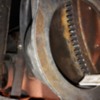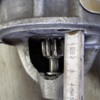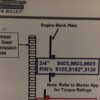I am curious.
Is the 351C installed in your 1975 Longchamp sourced from the US (a Q code 4V Cleveland) or is it sourced from Australia?
If from Australia, this may explain the parts difficulty. However I can provide some additional input.
I don't believe Australia had a C6 transmission. That was a transmission US Ford developed for its large displacement V8 engines. So a 351C sourced from Australia, if the flex plate & starter were Australian, may have employed 'adapters' to work with the North American C6.
Back in North America there were two iterations of the 351C 4V equipped with a C6 transmission.
In 1971 the 351 4V (the M code engine) was equipped with a C6 having a specific modulator valve, and a relatively low rpm stall torque converter (rated about 1500 to 1800 rpm).
In 1972 through 1974 the 351 CJ, 351 GT, or 351 4V (all Q code engines) were equipped with a C6 transmission having a different modulator valve, and a higher stall speed torque converter (rated about 2800 to 3000 rpm).
If the engine was Australian, the question would be which North American parts had it been adapted to work with? 1971 or 1972 - 1974? If you acquire the proper parts all designed for the same engine, they shall mesh together properly.
Just to complete the picture a bit better, here in North America, all 1970 351C engines mated to automatic transmissions were mated to FMX transmissions; in 1971 through 1974 only the 351C 2V engines (H code) mated to automatic transmissions were mated to FMX transmissions. I apologize I don't have information regarding Australian drive train ... but I would love to learn from an Aussie who could fill in that gap.





